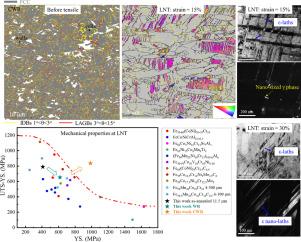控制入射位错边界和胞位排列促进了亚稳亚铁介质熵合金的多变量转变和强化应变硬化
IF 12.8
1区 材料科学
Q1 ENGINEERING, MECHANICAL
引用次数: 0
摘要
在这项工作中,我们引入并调节了入射位错边界(IDBs),通过连续冷温轧制(CWR)来定制亚稳铁Fe50Mn30Co10Cr10中熵合金(MEA)的细胞结构。这种方法旨在提高屈服强度(YS)而不影响延展性。与一步温轧(WR)相比,预先的冷变形引入了更高的移动位错密度和强化的位错-位错相互作用,促进了更细、更多的位错胞的形成。两种轧制样品均表现出较高的YS,同时保持均匀伸长率(UEL)水平,与无位错的退火参考样品相当。值得注意的是,CWR样品同时改善了YS和应变硬化率(SHR),并降低了力学各向异性,特别是在液氮温度(LNT)变形下。YS的增强主要是由于密集分布的位错细胞使晶粒细化,而力学各向异性的降低是由于{001}<;111>;由位错辅助再结晶引起的织构。虽然idb在早期变形过程中减缓了相变动力学,但CWR样品中精细的细胞结构促进了纳米片层ε-板条和微带的多种形核,从而产生了应变硬化的动态Hall-Petch屏障。流动应力的升高促进了纳米片层状ε-板条在微带内的扩散,并使多变体ε-板条剪切交点处形成可逆的γ-畴。因此,经cwr处理的MEA在LNT处获得了~ 985 MPa的高能谱,并保持了~ 3.5 GPa的特殊SHR。本研究建立了一种“位错工程”策略,以绕过亚稳铁MEAs中传统的强度-延性和YS-SHR权衡。本文章由计算机程序翻译,如有差异,请以英文原文为准。

The controlled incident dislocation boundaries and cell arrangements promoted multi-variant transformation and enhanced strain-hardening in a metastable ferrous medium entropy alloy
In this work, we introduced and regulated incident dislocation boundaries (IDBs) to tailor cellular structures in a metastable ferrous Fe50Mn30Co10Cr10 medium-entropy alloy (MEA) through successive cold-warm rolling (CWR). This approach aimed to enhance yield strength (YS) without compromising ductility. Compared to one-step warm rolling (WR), the prior cold deformation introduced a higher density of mobile dislocations and intensified dislocation-dislocation interactions, promoting the formation of finer and more numerous dislocation cells. Both rolled samples exhibited higher YS while maintaining uniform elongation (UEL) levels comparable to those of the dislocation-free as-annealed reference. Notably, the CWR samples demonstrated simultaneous improvements in YS and strain hardening rate (SHR), and reduced mechanical anisotropy, particularly under liquid nitrogen temperature (LNT) deformation. The enhanced YS primarily stems from grain refinement via densely distributed dislocation cells, while the reduced mechanical anisotropy arises from a weakened {001}<111> texture due to dislocation-assisted recrystallization. Although IDBs initially decelerate phase transformation kinetics during early deformation, the refined cell structure in CWR samples facilitates multi-variant nucleation of nano-lamellar ε-laths and microbands, thereby generating dynamic Hall-Petch barriers for strain hardening. Additionally, the elevated flow stress promotes the proliferation of nano-lamellar ε-laths within microbands and enables reversible γ-domain formation at the shear intersection zones of multi-variant ε-laths. Consequently, the CWR-processed MEA achieves a high YS of ∼985 MPa and sustains an exceptional SHR of ∼3.5 GPa at LNT. This study establishes a "dislocation engineering" strategy to circumvent the traditional strength-ductility and YS-SHR trade-offs in metastable ferrous MEAs.
求助全文
通过发布文献求助,成功后即可免费获取论文全文。
去求助
来源期刊

International Journal of Plasticity
工程技术-材料科学:综合
CiteScore
15.30
自引率
26.50%
发文量
256
审稿时长
46 days
期刊介绍:
International Journal of Plasticity aims to present original research encompassing all facets of plastic deformation, damage, and fracture behavior in both isotropic and anisotropic solids. This includes exploring the thermodynamics of plasticity and fracture, continuum theory, and macroscopic as well as microscopic phenomena.
Topics of interest span the plastic behavior of single crystals and polycrystalline metals, ceramics, rocks, soils, composites, nanocrystalline and microelectronics materials, shape memory alloys, ferroelectric ceramics, thin films, and polymers. Additionally, the journal covers plasticity aspects of failure and fracture mechanics. Contributions involving significant experimental, numerical, or theoretical advancements that enhance the understanding of the plastic behavior of solids are particularly valued. Papers addressing the modeling of finite nonlinear elastic deformation, bearing similarities to the modeling of plastic deformation, are also welcomed.
 求助内容:
求助内容: 应助结果提醒方式:
应助结果提醒方式:


